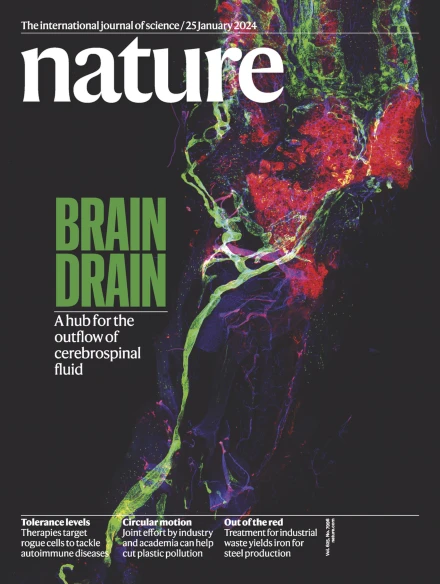A human brain map of mitochondrial respiratory capacity and diversity
IF 50.5
1区 综合性期刊
Q1 MULTIDISCIPLINARY SCIENCES
引用次数: 0
Abstract
Mitochondrial oxidative phosphorylation (OXPHOS) powers brain activity1,2, and mitochondrial defects are linked to neurodegenerative and neuropsychiatric disorders3,4. To understand the basis of brain activity and behaviour, there is a need to define the molecular energetic landscape of the brain5–10. Here, to bridge the scale gap between cognitive neuroscience and cell biology, we developed a physical voxelization approach to partition a frozen human coronal hemisphere section into 703 voxels comparable to neuroimaging resolution (3 × 3 × 3 mm). In each cortical and subcortical brain voxel, we profiled mitochondrial phenotypes, including OXPHOS enzyme activities, mitochondrial DNA and volume density, and mitochondria-specific respiratory capacity. We show that the human brain contains diverse mitochondrial phenotypes driven by both topology and cell types. Compared with white matter, grey matter contains >50% more mitochondria. Moreover, the mitochondria in grey matter are biochemically optimized for energy transformation, particularly among recently evolved cortical brain regions. Scaling these data to the whole brain, we created a backwards linear regression model that integrates several neuroimaging modalities11 to generate a brain-wide map of mitochondrial distribution and specialization. This model predicted mitochondrial characteristics in an independent brain region of the same donor brain. This approach and the resulting MitoBrainMap of mitochondrial phenotypes provide a foundation for exploring the molecular energetic landscape that enables normal brain function. This resource also relates to neuroimaging data and defines the subcellular basis for regionalized brain processes relevant to neuropsychiatric and neurodegenerative disorders. All data are available at http://humanmitobrainmap.bcblab.com . The ability to physically partition the human brain at a spatial resolution comparable to neuroimaging methods enabled the development of a brain-wide atlas of mitochondrial content, specialization and enzymatic oxidation and phosphorylation activities.

人类大脑的线粒体呼吸能力和多样性图
线粒体氧化磷酸化(OXPHOS)为大脑活动提供动力1,2,线粒体缺陷与神经退行性和神经精神疾病有关3,4。为了理解大脑活动和行为的基础,有必要定义大脑的分子能量景观5,6,7,8,9,10。在这里,为了弥合认知神经科学和细胞生物学之间的尺度差距,我们开发了一种物理体素化方法,将冷冻的人类冠状半球切片划分为703个体素,与神经成像分辨率(3 × 3 × 3 mm)相当。在每个皮质和皮质下脑体素中,我们分析了线粒体表型,包括OXPHOS酶活性、线粒体DNA和体积密度以及线粒体特异性呼吸能力。我们表明,人类大脑包含由拓扑结构和细胞类型驱动的多种线粒体表型。与白质相比,灰质中线粒体的含量多50%。此外,灰质中的线粒体在生物化学上优化了能量转换,特别是在最近进化的大脑皮质区域中。将这些数据扩展到整个大脑,我们创建了一个反向线性回归模型,该模型集成了几种神经成像模式,以生成线粒体分布和专门化的全脑地图。该模型预测了同一供体大脑中独立大脑区域的线粒体特征。这种方法和由此产生的线粒体表型MitoBrainMap为探索正常大脑功能的分子能量景观提供了基础。该资源还涉及神经影像学数据,并定义了与神经精神和神经退行性疾病相关的区域化脑过程的亚细胞基础。所有数据可在http://humanmitobrainmap.bcblab.com上获得。
本文章由计算机程序翻译,如有差异,请以英文原文为准。
求助全文
约1分钟内获得全文
求助全文
来源期刊

Nature
综合性期刊-综合性期刊
CiteScore
90.00
自引率
1.20%
发文量
3652
审稿时长
3 months
期刊介绍:
Nature is a prestigious international journal that publishes peer-reviewed research in various scientific and technological fields. The selection of articles is based on criteria such as originality, importance, interdisciplinary relevance, timeliness, accessibility, elegance, and surprising conclusions. In addition to showcasing significant scientific advances, Nature delivers rapid, authoritative, insightful news, and interpretation of current and upcoming trends impacting science, scientists, and the broader public. The journal serves a dual purpose: firstly, to promptly share noteworthy scientific advances and foster discussions among scientists, and secondly, to ensure the swift dissemination of scientific results globally, emphasizing their significance for knowledge, culture, and daily life.
 求助内容:
求助内容: 应助结果提醒方式:
应助结果提醒方式:


